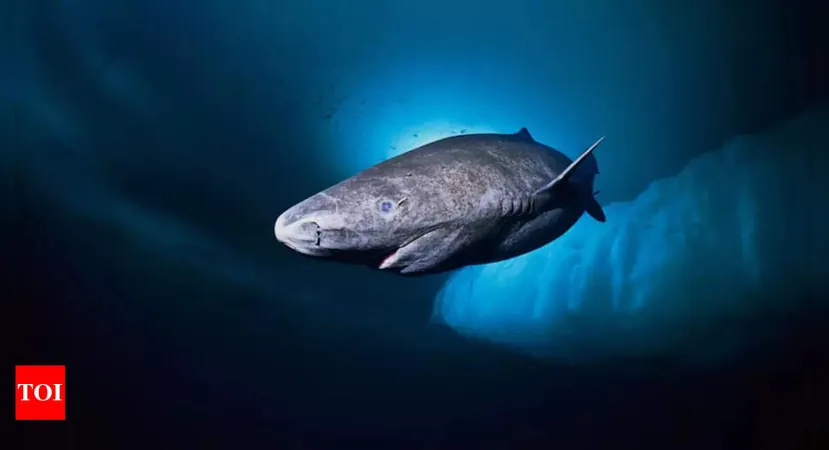
Meet the Greenland Shark: The Ocean's 400-Year-Old Wonder!
2024-11-19
Author: Jia
Researchers have unveiled a jaw-dropping discovery: the Greenland shark is not just a mysterious deep-sea creature, but a true marvel of longevity, potentially reaching ages of over 400 years! This incredible species, known scientifically as Somniosus microcephalus, has been swimming the chilly waters of our planet since the 17th century, long before the era of modern civilization.
The Oldest Fish in the Sea
Surpassing even the legendary bowhead whale, which can live up to 211 years, the Greenland shark stands as the oldest living vertebrate known to science. An individual shark swimming in the ocean today could have been alive since the 1600s! Their lifespan is a testament to their unique adaptations to the harsh Arctic environment where they thrive.
The Breakthrough in Age-Determining Techniques
Determining the age of these sharks was once an enigma for scientists due to their lack of growth rings, a feature typically found in the skeletal structures of many vertebrates. However, a groundbreaking technique borrowed from forensic science has changed the game. Jan Heinemeier, a radiocarbon dating expert, developed a method to estimate age using the lens of a Greenland shark's eye, similar to how scientists date human remains. This innovative approach has allowed researchers to uncover the astonishing longevity of these elusive creatures.
Why Do They Live So Long?
Though the exact reasons behind their longevity remain a subject of ongoing research, several factors likely contribute. The icy waters, with temperatures around -1.6°C (29°F), play a critical role, possibly offering anti-aging benefits. Additionally, their slow metabolism allows for a leisurely lifestyle, which may contribute to their extended lifespan. Researchers are also delving into the genetics and immune systems of these sharks, hoping to uncover secrets that could someday enhance human health and longevity.
Size and Mysterious Characteristics
These extraordinary sharks can reach lengths of up to 24 feet (7.3 meters) and weigh around 2,645 pounds (1,200 kg), making them one of the largest shark species. However, they grow at an incredibly slow rate of just 1 centimeter a year, with sexual maturity reached only after 150 years. Interestingly, many Greenland sharks are observed with copepods—small crustaceans—attached to their eyes, which might impair their vision, yet the implications of this phenomenon are still being studied.
Diet and Hunting Practices
As apex predators, Greenland sharks have a diverse diet. While they do hunt seals and fish, they are opportunistic feeders that are known to scavenge on carcasses of animals like polar bears and reindeer that fall through the ice. This scavenging behavior not only reduces the energy spent on hunting but also allows them to thrive in some of the most remote and inhospitable marine environments.
Relationship with Humans
Despite their ominous size, encounters with humans are exceedingly rare. These deep-sea dwellers typically get caught inadvertently in fishing nets, but there are no recorded attacks on people. Their reclusive nature and preference for the cold depths of the ocean keep them largely isolated from human interaction.
The Future of the Greenland Shark
While exact numbers of the Greenland shark population are still unclear, initial observations suggest they are not currently facing major threats from human activities. Marine biologist Steven Campana indicates that their presence in certain regions is a positive sign, implying that their populations remain stable despite environmental changes. However, ongoing research is essential to fully understand their ecological status and ensure their preservation for generations to come.
In conclusion, the Greenland shark may not be the most ferocious predator in the ocean, but its unique adaptations and staggering lifespan make it a fascinating subject for scientists and ocean enthusiasts alike. This ancient sentinel of the sea continues to intrigue with its secrets and resilience, proving that even in the depths of the ocean, life can tell a story of remarkable endurance.



 Brasil (PT)
Brasil (PT)
 Canada (EN)
Canada (EN)
 Chile (ES)
Chile (ES)
 España (ES)
España (ES)
 France (FR)
France (FR)
 Hong Kong (EN)
Hong Kong (EN)
 Italia (IT)
Italia (IT)
 日本 (JA)
日本 (JA)
 Magyarország (HU)
Magyarország (HU)
 Norge (NO)
Norge (NO)
 Polska (PL)
Polska (PL)
 Schweiz (DE)
Schweiz (DE)
 Singapore (EN)
Singapore (EN)
 Sverige (SV)
Sverige (SV)
 Suomi (FI)
Suomi (FI)
 Türkiye (TR)
Türkiye (TR)